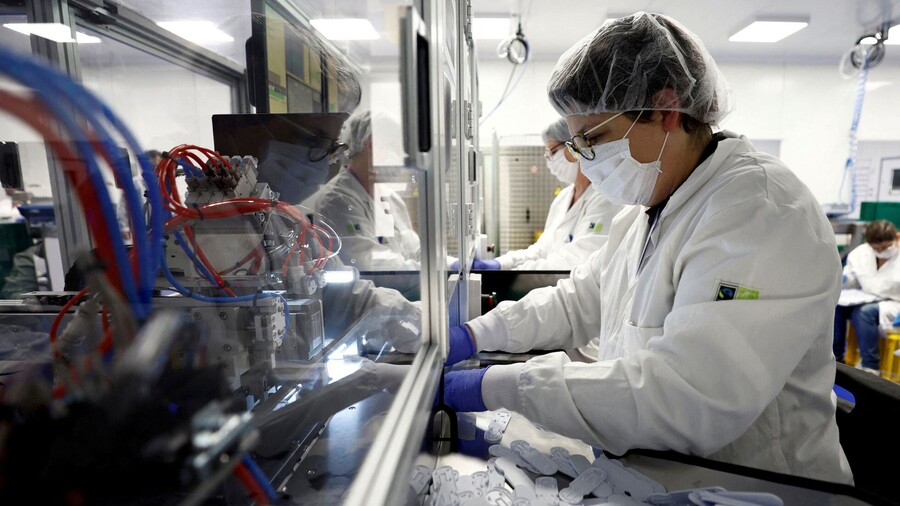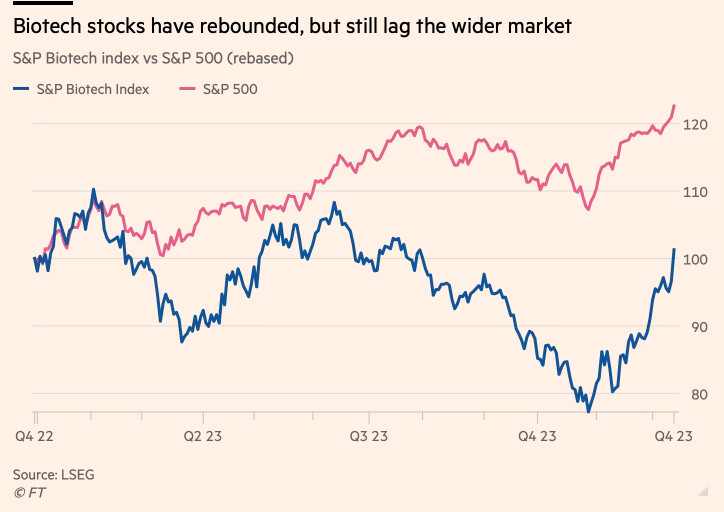-
[경제] (FT) 잿더미 속에서 부활할 바이오텍2023.12.15 PM 01:28
2024년 금리인하 장세가 가시화되면 가장 수혜를 볼 수 있는 업종이 바이오텍이 될 수 있다는 FT 이슈 기사입니다
================
- 미국 주식시장이 사상 최고치에 근접했지만 S&P Biotech 지수는 2021년 고점대비 여전히 50% 낮은 수준을 유지
- 그러나 2024년 금리인하 기대가 피어오르며 최대 수혜가 될 것이라는 기대감이 확산되고 있음. 11월 초 저점 대비 25%나 반등한 이유
- Janus Henderson 포트폴리오 매니저, "판데믹 당시 early-stage의 기업들이 말도 안되는 높은 밸류에이션을 받았었는데, 이제는 정반대 상황이 펼쳐지고 있음. 이제는 완전히 폐허가 되어버렸고, 그 잔해를 뒤지고 있는 형국"
- 지수 하락의 가장 큰 원인은 백신업체 Moderna와 비만치료제 개발업체인 Altimmune 때문. Moderna는 판데믹이 끝나면서 폭락했고 Altimmune은 심각한 부작용으로 급락
- 2023년 10월 기준 글로벌 바이오텍 중 232개 기업이 보유 현금액보다 시가총액이 낮은 기현상까지 발생. 화이자까지 어닝쇼크로 망가지며 더 분위기는 싸해짐
- 금리 상승은 바이오텍 밸류에이션에 영향을 줄 수밖에 없음. 바이오텍은 미래의 성장성으로 평가할 수밖에 없기 때문
- 2020-21년 당시 IPO할 준비가 안되어 있는 업체들이 마구잡이로 상장한 것에 대한 자기반성도 나오고 있음. 2020-21년 250개나 되는 헬스케어 기업이 상장했는데, 퍼포먼스가 너무 안좋아 후속 투자가 이루어지기 어려운 분위기가 만들어짐
- 그러나 비만 치료제 등 일부 분야는 계속 투자자들이 자금을 싸들고 오고 있으며 혁신은 지속. 약가 인하 등 압력과 대선 이슈 등이 있긴 하나 낙관주의적 훈풍이 오랜만에 나타나기 시작한 것에 주목
- 더 많은 기업들이 자본조달에 성공할 수 있고, 일반 투자자들이 돌아오기 시작할 것으로 기대
- 신영증권 리서치센터 자산전략팀 박소연 이사 -
================================================
(Financial Times) Biotech stocks undergo recovery after year of ‘wreckage’
https://www.ft.com/content/f2c97f94-3c88-446b-a05b-2eed14843435
Sector benefits from shifts in interest rate expectations after 50% fall

The number of new US listings of healthcare companies has contracted this year © Stephane Mahe/Reuters
Nicholas Megaw and Anna Mutoh in New York yesterday
A rally in biotech stocks has raised hopes of a turnaround from the sector’s worst run this century, as drug developers suffered from rising interest rates and a backlash to pandemic-era euphoria.
Even as the wider US stock market approaches a record high, the S&P biotechnology index remains more than 50 per cent below its early 2021 peak.
However, the sector has been one of the biggest beneficiaries of a recent shift in interest rate expectations, bouncing more than 25 per cent since the start of November. A 5 per cent gain on Wednesday pushed it into positive territory for the year after declines of more than 20 per cent in 2021 and 2022.
“In late 2020 and early 2021, many early-stage companies hit valuations that didn’t make any sense,” said Andy Acker, a healthcare portfolio manager at Janus Henderson. “Now we have the opposite situation . . . [so] we’re combing through the wreckage to try to identify companies that have been left for dead.”
Some of the biggest contributors to the index’s recent weakness include vaccine developer Moderna and Altimmune, which is developing anti-obesity treatments.
Moderna’s shares have tumbled more than 50 per cent this year as demand for its Covid-19 vaccines wanes. Altimmune lost more than half of its value in a single March day after a drug trial showed severe side effects for some patients.
In October, before the recent market rally, a record 232 life sciences companies globally were trading with a market capitalisation below their cash reserves, according to Janus Henderson.
Large drugmakers have also underperformed, with the S&P 500 pharmaceutical sub-index heading for its worst performance relative to the broader S&P 500 in at least 20 years. Pfizer has been the biggest drag on the S&P 500 this year, and on Wednesday hit its lowest level since 2013.

Rising interest rates have weighed on valuations across industries, but the effect tends to be particularly damaging in sectors such as biotech where most companies focus on growth far in the future. The Federal Reserve on Wednesday left benchmark US interest rates at 5.25-5.5 per cent, up from near zero two years ago, but signalled cuts will begin next year.
Chris Shibutani, a healthcare analyst at Goldman Sachs, said: “I have never been in a multiyear phase where macro dynamics have had as much influence as now. Almost every investor has had to become an armchair economist.”
The impact of rates has been exacerbated by an influx of high-risk companies that went public in 2020 and 2021.
Traditionally, start-ups working on new drugs would raise funding privately until they had clinical data to reassure investors about their chances of success.
When markets were surging at the height of the coronavirus pandemic, however, many companies listed their stock with little data.
“There were companies that, if we were all honest with ourselves, probably weren’t ready to be public,” said Rahul Chaudhary, head of healthcare equity capital markets at Leerink Partners.
More than 250 healthcare companies listed in the US between 2020 and 2021, according to Dealogic. Their poor performance has made it harder for others to follow them, with just 24 deals in 2023.
Some companies specialising in areas such as anti-obesity drugs have managed to attract investors despite the tough environment. “Innovation is still happening in the sector, the problem is some innovation has not been valued highly,” said Lorence Kim, managing partner at Ascenta Capital and a former chief financial officer at Moderna.
Kim said that should create opportunities for investors, with “a half-off sale in everything” before the macro picture changes.
Goldman’s Shibutani cautioned that the industry would still face challenges even when interest rates begin to fall, including drug pricing reforms and a looming US presidential election.
Still, belief that the Fed will soon start cutting rates has already started to boost valuations, with the biotech index up 14 per cent in November and 11 per cent this month.
“I think it is nascent optimism right now,” said Chaudhary. “But hope springs eternal, and there is hope that next year the lower rate environment will start to help the sector, you’ll see more companies be able to access capital and importantly you’ll see the generalist investors — who have been absent for three years — start to come back.”
user error : Error. B.